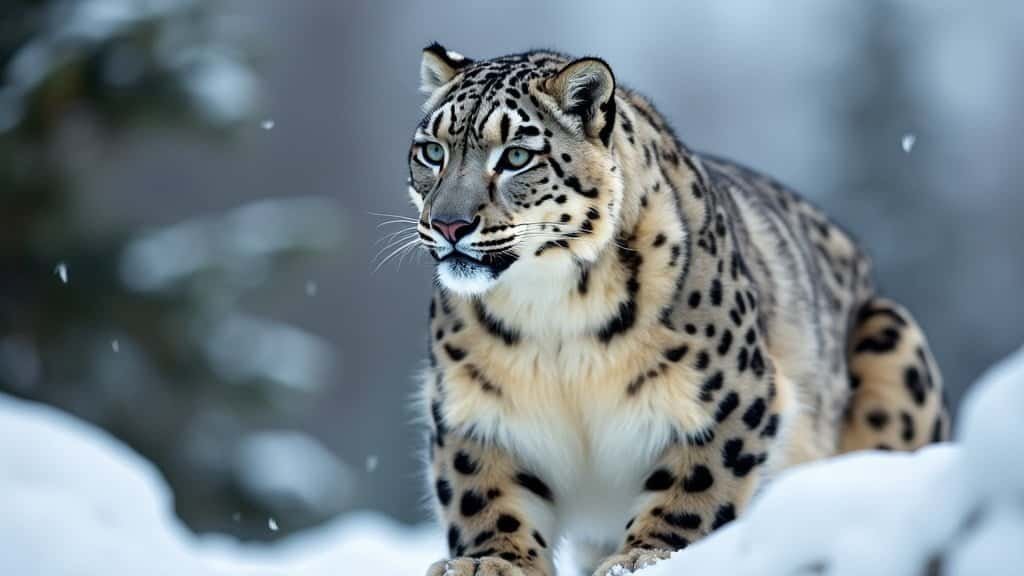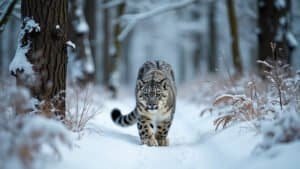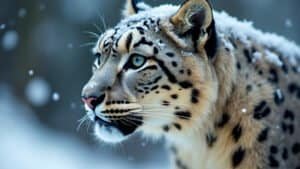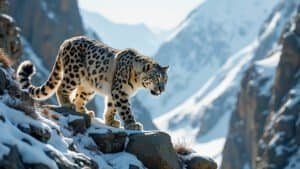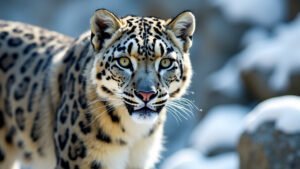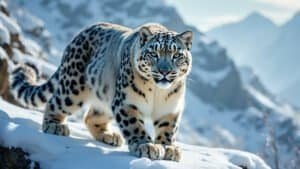Introduction
Snow leopards, with their elusive nature and striking appearance, are among the most fascinating big cats in the world. However, beneath their majestic fur lies a genetic blueprint that shapes their physical traits
This article delves into how genetic mutations impact the physical characteristics of snow leopards, from their distinctive coat patterns to their overall body structure. We will explore common mutations, their effects on appearance, and the broader implications for the health and evolution of these magnificent creatures
Common Genetic Mutations in Snow Leopards
Genetic mutations play a crucial role in the diversity and adaptability of species, including snow leopards. These mutations, which are changes in the DNA sequence, can occur naturally over time or due to environmental factors
In snow leopards, genetic mutations can lead to variations in physical traits, such as coat color, spot patterns, and even body structure. Understanding these mutations helps researchers gain insights into how these big cats have evolved and how they continue to adapt to their harsh environments
What Are Genetic Mutations?
Genetic mutations refer to alterations in the DNA sequence that can occur spontaneously or due to external influences like radiation or chemicals
These changes can affect a single nucleotide (point mutation) or larger segments of DNA, leading to more significant alterations in an organism’s traits. While some mutations can be harmful, others may be neutral or even beneficial, contributing to the species’ ability to survive and thrive in changing environments
In snow leopards, genetic mutations have been observed to impact various aspects of their physiology and appearance
Specific Mutations Found in Snow Leopards
Researchers have identified several genetic mutations in snow leopards that influence their physical characteristics. One of the most well-documented mutations affects the MC1R gene, which plays a key role in regulating pigment production
Variations in this gene can lead to different coat colors and patterns, such as darker or lighter fur, which can help snow leopards blend into their surroundings. Another mutation, found in the ASIP gene, has been linked to variations in the distribution and shape of the spots on a snow leopard’s coat. These mutations are crucial for understanding the diversity of appearance within the species
In a study conducted by McCarthy et al. (2017), the genetic diversity of snow leopards across their range was analyzed. The researchers found that mutations in these key genes not only contribute to variations in appearance but also to the adaptability of snow leopards in different environments
For example, snow leopards living in areas with more snow tend to have lighter coats, a trait that can be traced back to specific genetic mutations
Examples of Coat Color Variations
The coat of a snow leopard is one of its most striking features, and genetic mutations play a significant role in the variations seen in different individuals. Typically, snow leopards have a grayish coat with black rosettes, but due to genetic mutations, some snow leopards exhibit different color patterns
For instance, some individuals may have a more yellowish or reddish hue to their fur, which is less common but can occur due to mutations in genes involved in melanin production. These variations not only affect the leopard’s appearance but also its ability to camouflage in different environments
In regions where snow is prevalent year-round, lighter-colored snow leopards are more common, as their coat provides better camouflage against the snow-covered landscape
Conversely, in areas with less snow, darker-coated leopards may have a survival advantage. This variation highlights the importance of genetic mutations in helping snow leopards adapt to their specific habitats, thereby increasing their chances of survival
Impact of Mutations on Coat Patterns
The coat patterns of snow leopards are not just a hallmark of their beauty but also a critical aspect of their survival
These patterns, consisting of rosettes, spots, and background coloration, are heavily influenced by genetic mutations. Understanding how these mutations affect coat patterns provides valuable insights into the adaptability and evolution of snow leopards
How Mutations Influence Spot Shape and Size
Genetic mutations can significantly alter the size, shape, and distribution of the spots and rosettes on a snow leopard’s coat. The gene responsible for the formation of these patterns is the Taqpep gene, which has been studied extensively in felines
Variations or mutations in this gene can result in differences in the size and arrangement of spots, leading to unique patterns that can be specific to certain populations or even individuals
For example, some snow leopards may have larger, more irregularly shaped rosettes due to mutations in the Taqpep gene, while others may exhibit smaller, more closely spaced spots. These variations can be critical for camouflage, as they allow snow leopards to blend into various terrains, from rocky outcrops to snowy expanses
The ability to remain hidden from prey and predators alike is essential for the survival of these big cats, and genetic mutations that alter coat patterns play a crucial role in this adaptive process
Variations in Coat Patterns Across Different Regions
The geographic range of snow leopards spans across various countries and landscapes, from the Himalayas to the steppes of Central Asia
Interestingly, the coat patterns of snow leopards can vary depending on the region they inhabit, a phenomenon largely attributed to genetic mutations. In areas with dense vegetation or rocky terrains, snow leopards tend to have more complex and darker patterns, which help them blend into their surroundings
In contrast, snow leopards living in areas with extensive snow cover often have lighter coats with simpler and more dispersed patterns. These regional variations are a direct result of natural selection, where mutations that favor better camouflage in a specific environment are passed on to future generations
A study by Janecka et al. (2019) revealed that snow leopards in the Altai Mountains, where the terrain is more rocky, exhibit more densely packed spots compared to those in the Tibetan Plateau, where the leopards have lighter and less intricate patterns
Case Studies on Snow Leopard Fur Patterns
To further illustrate the impact of genetic mutations on snow leopard coat patterns, several case studies have been conducted
One such study focused on a population of snow leopards in Mongolia, where researchers found a significant degree of variation in coat patterns within a relatively small geographic area. This variation was linked to specific genetic mutations that were more prevalent in certain subpopulations, suggesting that these mutations may provide some adaptive advantage in the varying environments
Another case study conducted in the Himalayas showed that snow leopards with larger, more distinct rosettes were more successful in mountainous regions with broken terrain, as these patterns provided better camouflage. On the other hand, snow leopards with smaller, more uniform spots were better suited to areas with more open, snowy landscapes
These studies highlight how genetic mutations can lead to physical characteristics that are finely tuned to the specific needs of different environments, demonstrating the remarkable adaptability of snow leopards
Physical Structure Changes Due to Mutations
While coat patterns and coloration are the most visible aspects influenced by genetic mutations in snow leopards, these changes can also extend to their physical structure
Mutations can affect the size, shape, and functionality of various body parts, contributing to the snow leopard’s remarkable adaptation to its harsh mountainous environment
Effects on Snow Leopard Body Size and Shape
Genetic mutations can play a significant role in determining the overall size and shape of snow leopards. These mutations can affect growth factors and other genetic pathways responsible for bone development and muscle formation
For instance, certain mutations might lead to variations in limb length or muscle mass, which can influence the leopard’s agility and hunting efficiency
Snow leopards are known for their powerful build, with strong hind legs that allow them to leap great distances—up to 50 feet in a single bound
Mutations that enhance muscle development in the hind limbs can give certain individuals a survival advantage by improving their ability to traverse rugged terrain and catch prey. On the other hand, mutations that negatively impact growth or muscle development can result in smaller, less robust individuals, which might be less successful in the wild
A study by Li et al. (2020) examined the genetic basis of body size variation in snow leopards and found that certain mutations in growth hormone-related genes could be linked to differences in overall body size among different populations
These findings suggest that genetic diversity within the species is essential for maintaining a range of physical characteristics that can help snow leopards survive in diverse environments
Skeletal and Muscular Variations
The skeletal structure of snow leopards is uniquely adapted to their environment, and genetic mutations can lead to variations that affect their mobility and hunting capabilities
For example, mutations that affect the development of the spine or pelvis can influence the flexibility and strength of these areas, which are critical for the snow leopard’s ability to make sharp turns while chasing prey in rocky terrains
Additionally, muscular variations due to genetic mutations can impact the strength and endurance of snow leopards. Mutations in genes responsible for muscle fiber composition can lead to differences in fast-twitch versus slow-twitch muscle fibers, affecting the leopard’s speed and stamina
Snow leopards with a higher proportion of fast-twitch fibers might be better suited for short bursts of speed, crucial for ambushing prey, while those with more slow-twitch fibers might excel in endurance, helping them traverse long distances in search of food
In a research study conducted by Sharma et al. (2018), the muscle composition of snow leopards from different regions was analyzed, revealing significant genetic variation that correlated with their physical abilities
For instance, snow leopards from higher altitudes showed a greater proportion of slow-twitch muscle fibers, which are more efficient in low-oxygen environments, a critical adaptation for life in the high Himalayas
Adaptations in Response to Environmental Conditions
Snow leopards inhabit some of the most extreme environments on Earth, and genetic mutations that affect their physical structure often contribute to their ability to survive these harsh conditions
For example, mutations that influence the development of a thicker, more insulating fur coat are vital for withstanding the freezing temperatures of the Himalayas and other high-altitude regions
Other structural adaptations that may result from genetic mutations include changes in paw size and shape. Snow leopards have large, fur-covered paws that act like snowshoes, distributing their weight more evenly across the snow and preventing them from sinking
Mutations that enhance these features can provide a significant advantage in snowy environments, improving their ability to hunt and move efficiently
A study by He et al. (2021) highlighted the role of genetic mutations in the adaptation of snow leopards to cold environments. The study found that mutations in genes related to fat metabolism and thermoregulation were more prevalent in snow leopards living in higher altitudes, suggesting that these genetic changes were critical for their survival in extreme cold
Health and Evolutionary Implications
Genetic mutations, while driving diversity and adaptability in snow leopards, can also have significant health and evolutionary implications. These mutations not only influence the physical traits of these big cats but also play a role in their long-term survival and evolution
Potential Health Issues from Genetic Mutations
While some genetic mutations are beneficial or neutral, others can lead to health problems in snow leopards. Mutations that result in faulty gene function can cause various disorders, from metabolic issues to physical deformities
For instance, mutations affecting the immune system can make snow leopards more susceptible to diseases, which could be particularly devastating in small, isolated populations
Inbreeding, a common issue in small populations, can exacerbate the effects of harmful mutations. When a population is small and isolated, the gene pool is limited, and the likelihood of inheriting two copies of a harmful mutation increases. This can lead to genetic disorders that might not be as prevalent in larger, more genetically diverse populations
A study by Johansson et al. (2019) found evidence of inbreeding depression in certain snow leopard populations, where genetic diversity was low, and the frequency of certain deleterious mutations was higher, leading to reduced overall fitness
Additionally, mutations in genes related to reproduction can affect fertility and litter size, potentially impacting population growth. For example, a mutation in the FSHB gene, which influences reproductive hormones, could lead to reduced fertility in female snow leopards, limiting the number of offspring they can produce over their lifetime
Such mutations could have long-term effects on population viability, especially in fragmented habitats where snow leopards are already struggling to survive
Role in Evolution and Survival of the Species
Despite the potential risks, genetic mutations are also a driving force behind the evolution and adaptability of snow leopards
Over time, beneficial mutations can spread through a population, leading to adaptations that enhance survival in specific environments. This process, known as natural selection, allows snow leopards to continue thriving in some of the most challenging habitats on Earth
For instance, mutations that enhance the snow leopard’s ability to survive in cold climates—such as those that increase fur thickness or improve fat metabolism—can provide a selective advantage
These traits become more common in populations living in harsh, high-altitude environments, ensuring that snow leopards remain well-adapted to their surroundings. This evolutionary process has helped snow leopards survive in the Himalayas, the Pamirs, and other mountainous regions where few other predators can thrive
The genetic diversity resulting from mutations is also crucial for the species’ resilience to environmental changes and diseases. A population with a wide range of genetic traits is better equipped to adapt to changing conditions, such as climate change or new diseases
For example, snow leopards with genetic mutations that improve heat tolerance might have a better chance of surviving in regions where temperatures are rising due to climate change. This adaptability is essential for the long-term survival of the species in a rapidly changing world
Conservation Efforts and Genetic Diversity
The health and evolutionary potential of snow leopards are closely linked to their genetic diversity. Conservation efforts aimed at preserving and enhancing this diversity are vital for the species’ future. One approach to maintaining genetic diversity is through the management of wild populations and captive breeding programs that ensure a broad gene pool
Captive breeding programs, such as those managed by the Global Species Management Plan (GSMP), play a critical role in preserving genetic diversity
These programs carefully manage breeding pairs to maximize genetic variation and minimize the risk of inbreeding. Genetic studies are often used to guide breeding decisions, ensuring that the offspring contribute positively to the overall genetic health of the population
In the wild, conservation strategies that focus on protecting and connecting snow leopard habitats can help maintain genetic diversity by facilitating gene flow between populations
Corridors that allow snow leopards to move between different regions can prevent the isolation of populations and reduce the risk of inbreeding. This approach is particularly important in fragmented landscapes where human activities have disrupted traditional migration routes
A study by Mallon et al. (2021) highlighted the importance of habitat connectivity for snow leopard conservation. The researchers found that connected populations had higher genetic diversity and were more resilient to environmental changes than isolated ones
These findings underscore the need for comprehensive conservation strategies that address both genetic and ecological factors to ensure the long-term survival of snow leopards
Conclusion
Genetic mutations play a pivotal role in shaping the physical characteristics of snow leopards, from their distinctive coat patterns to their overall body structure. These mutations contribute to the incredible adaptability of snow leopards, enabling them to thrive in some of the world’s most challenging environments
However, while many mutations offer adaptive advantages, others can pose health risks, particularly in small, isolated populations. Understanding the balance between these effects is crucial for the conservation of this elusive species
By protecting genetic diversity through careful management and conservation efforts, we can help ensure that snow leopards continue to roam the rugged mountains of Asia for generations to come
